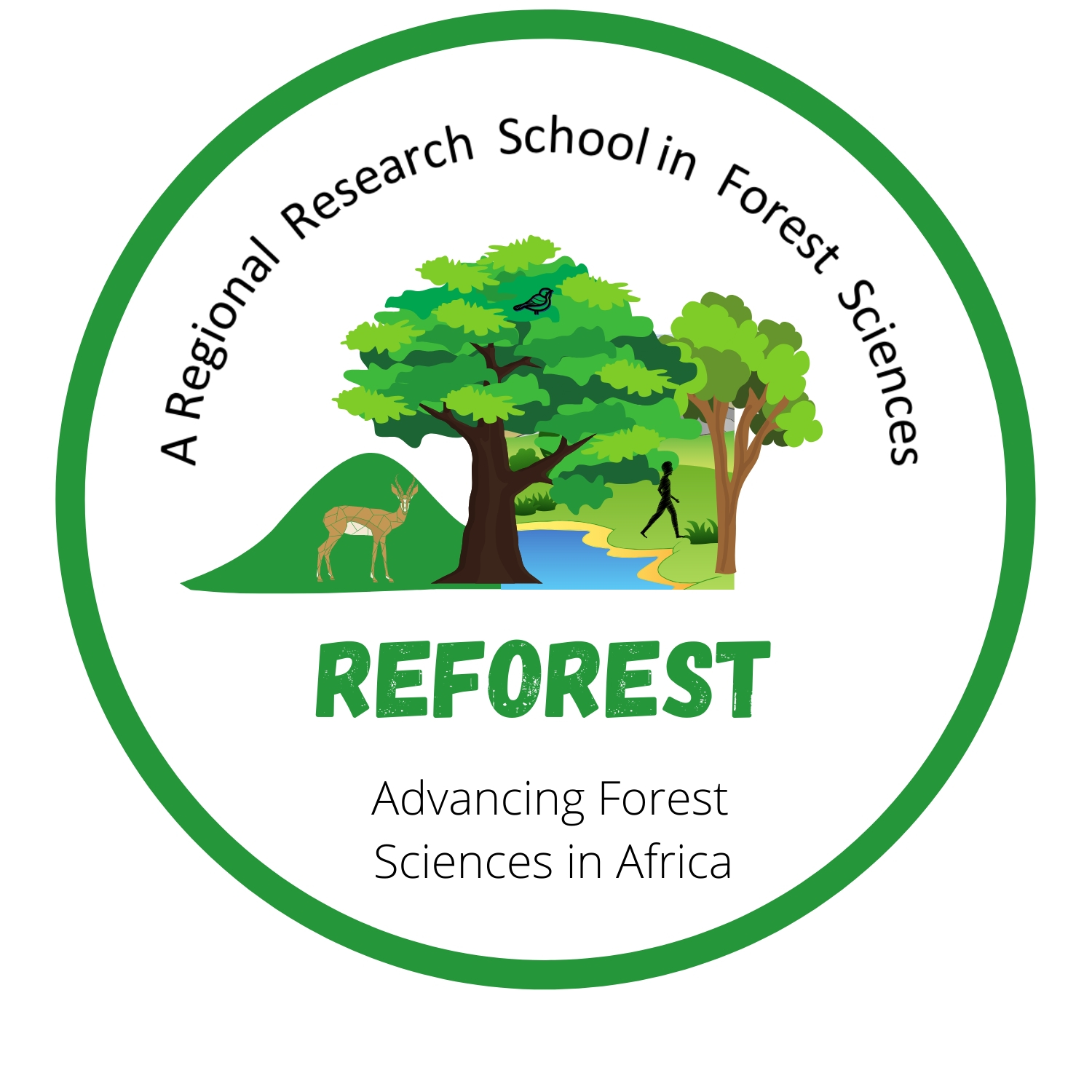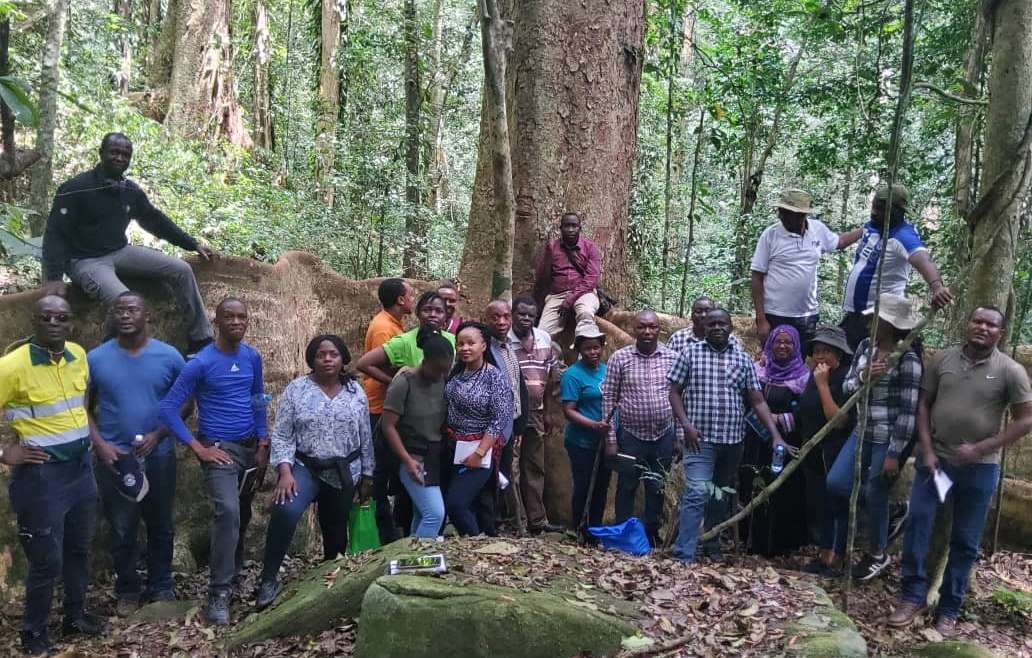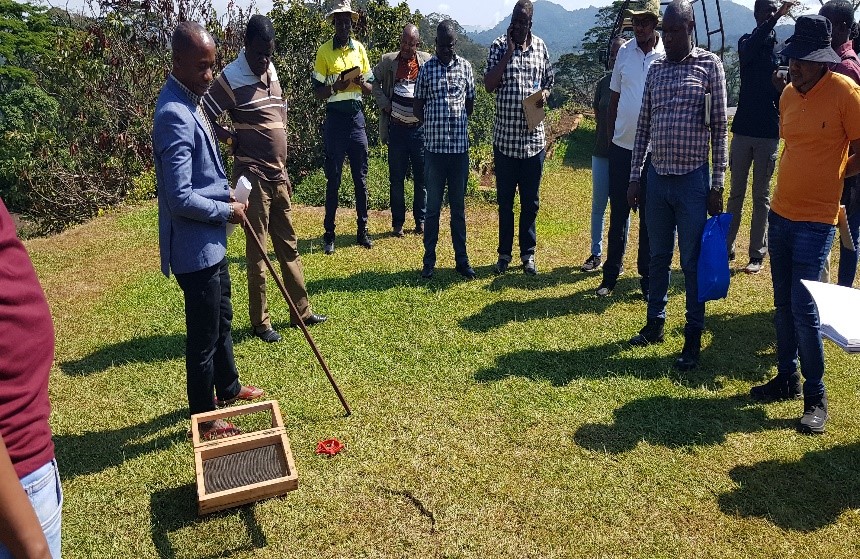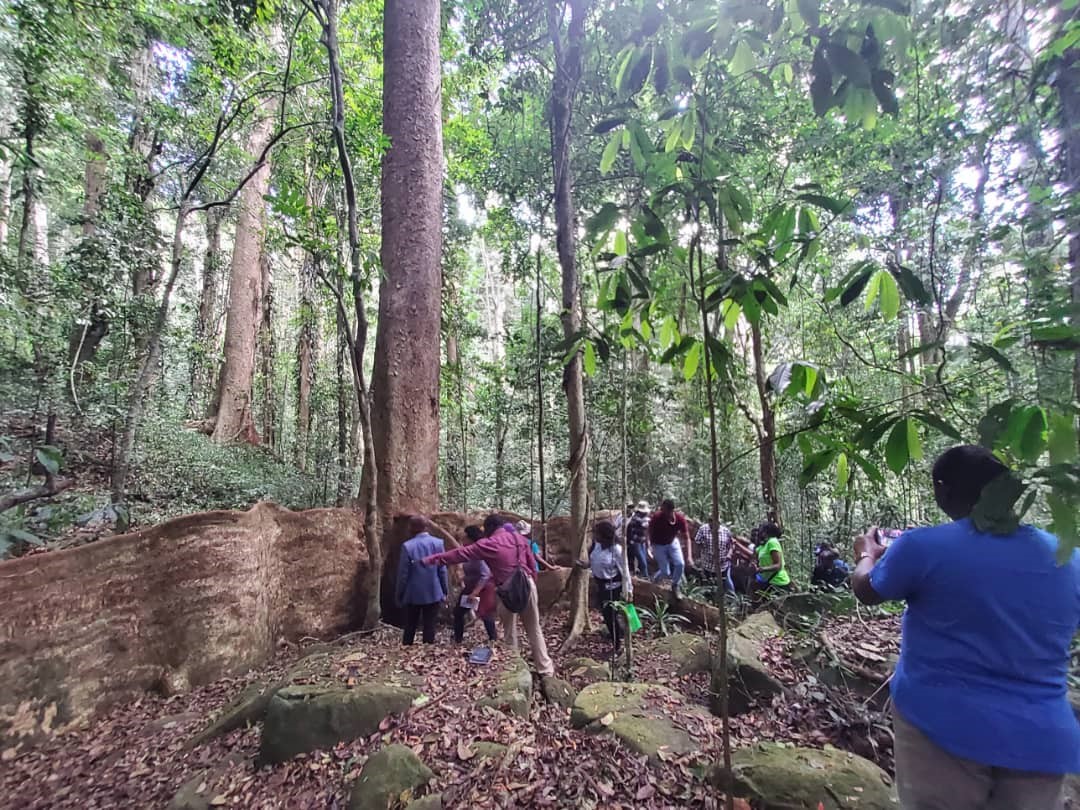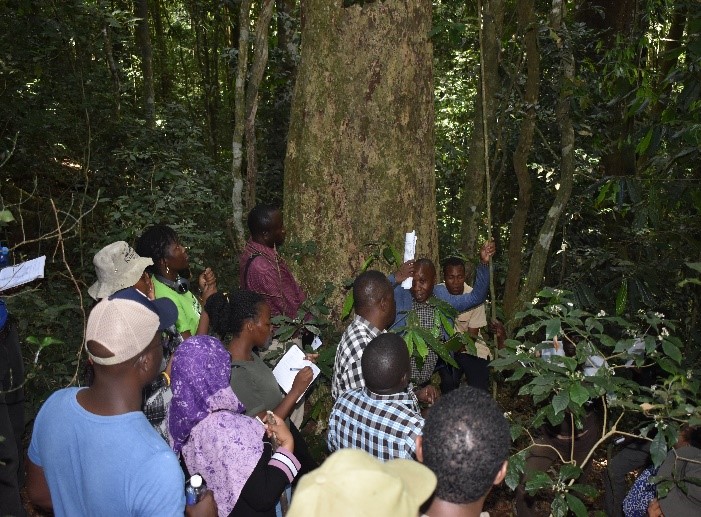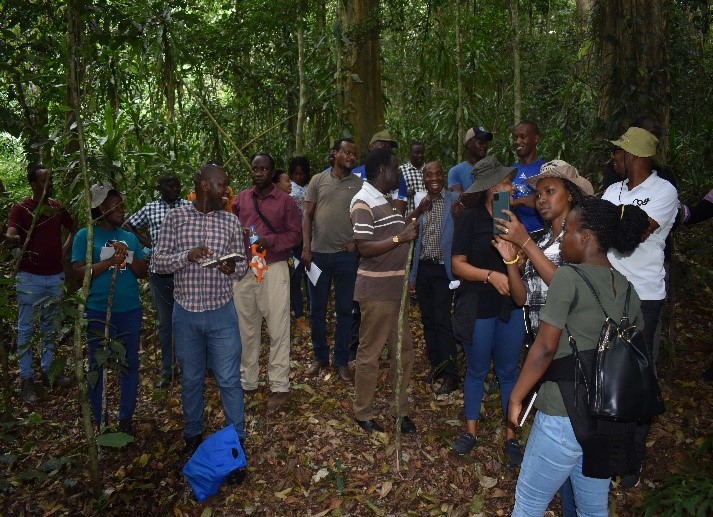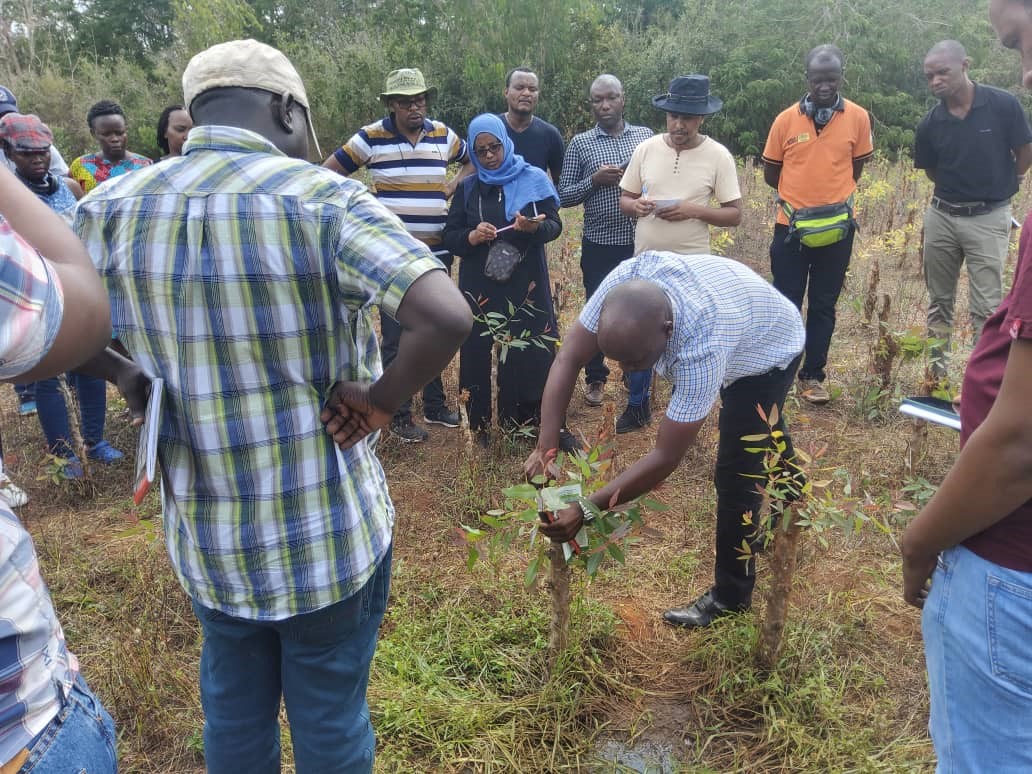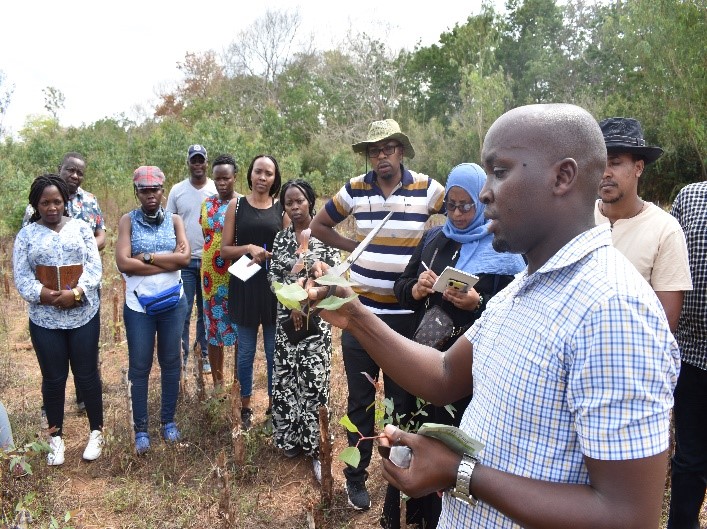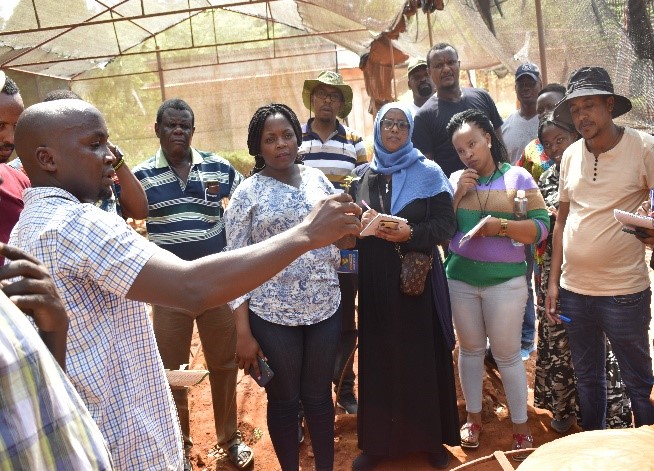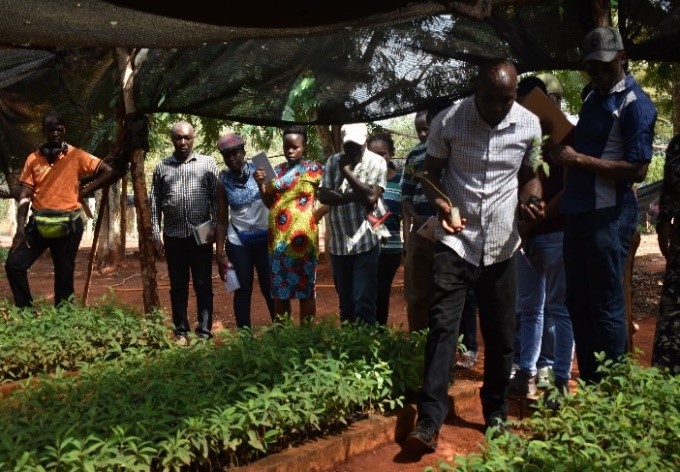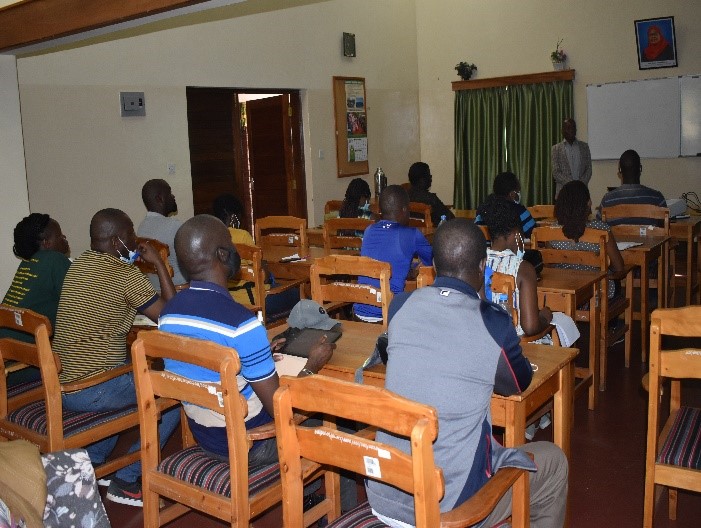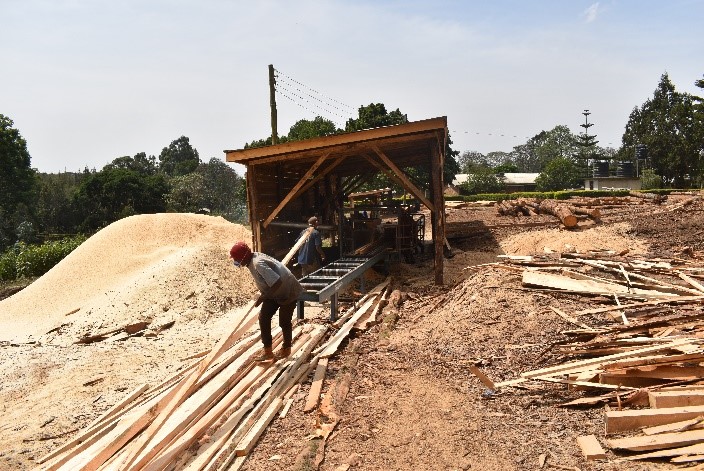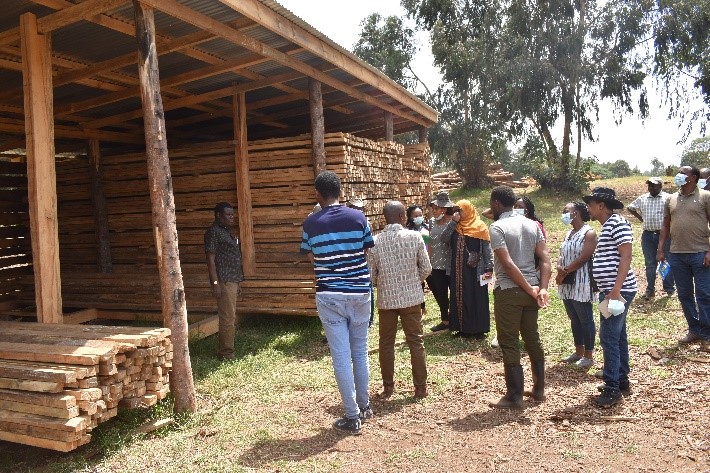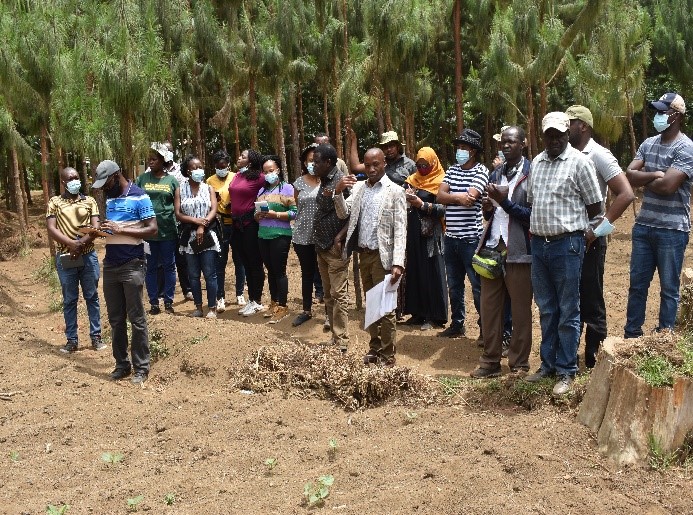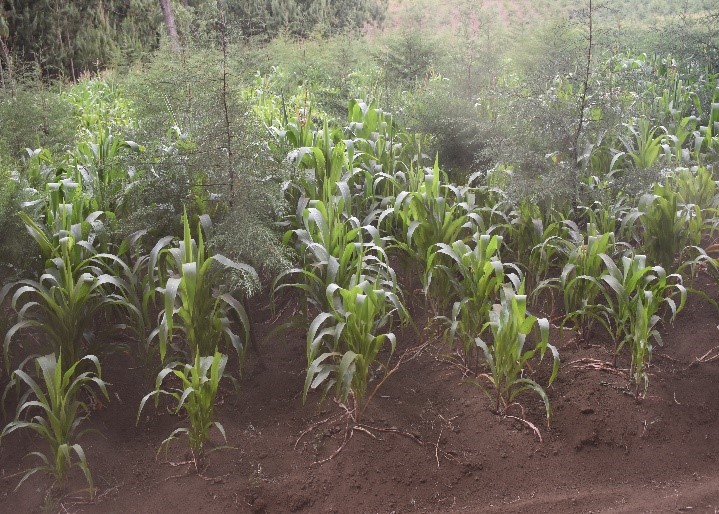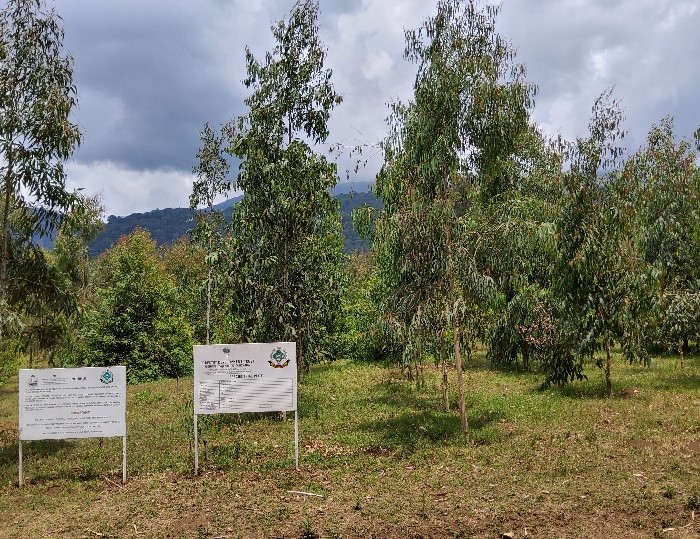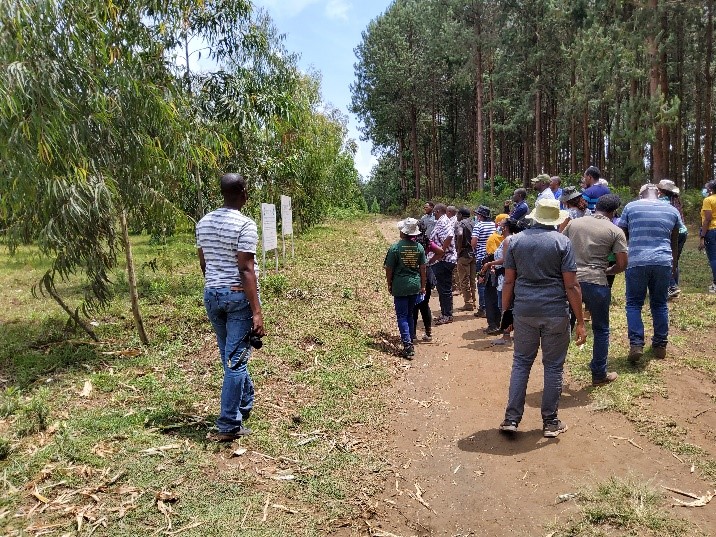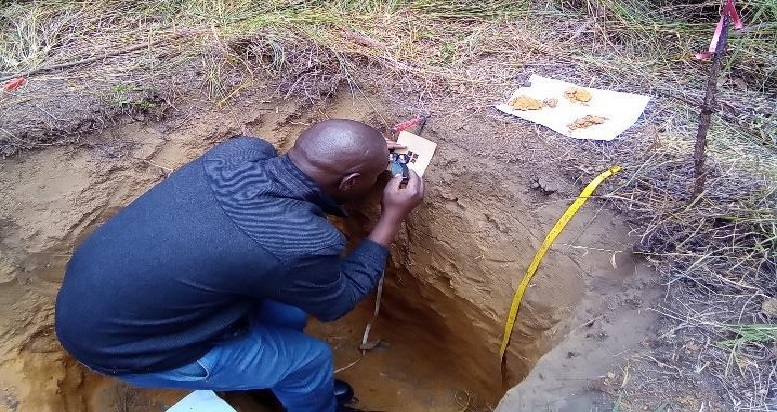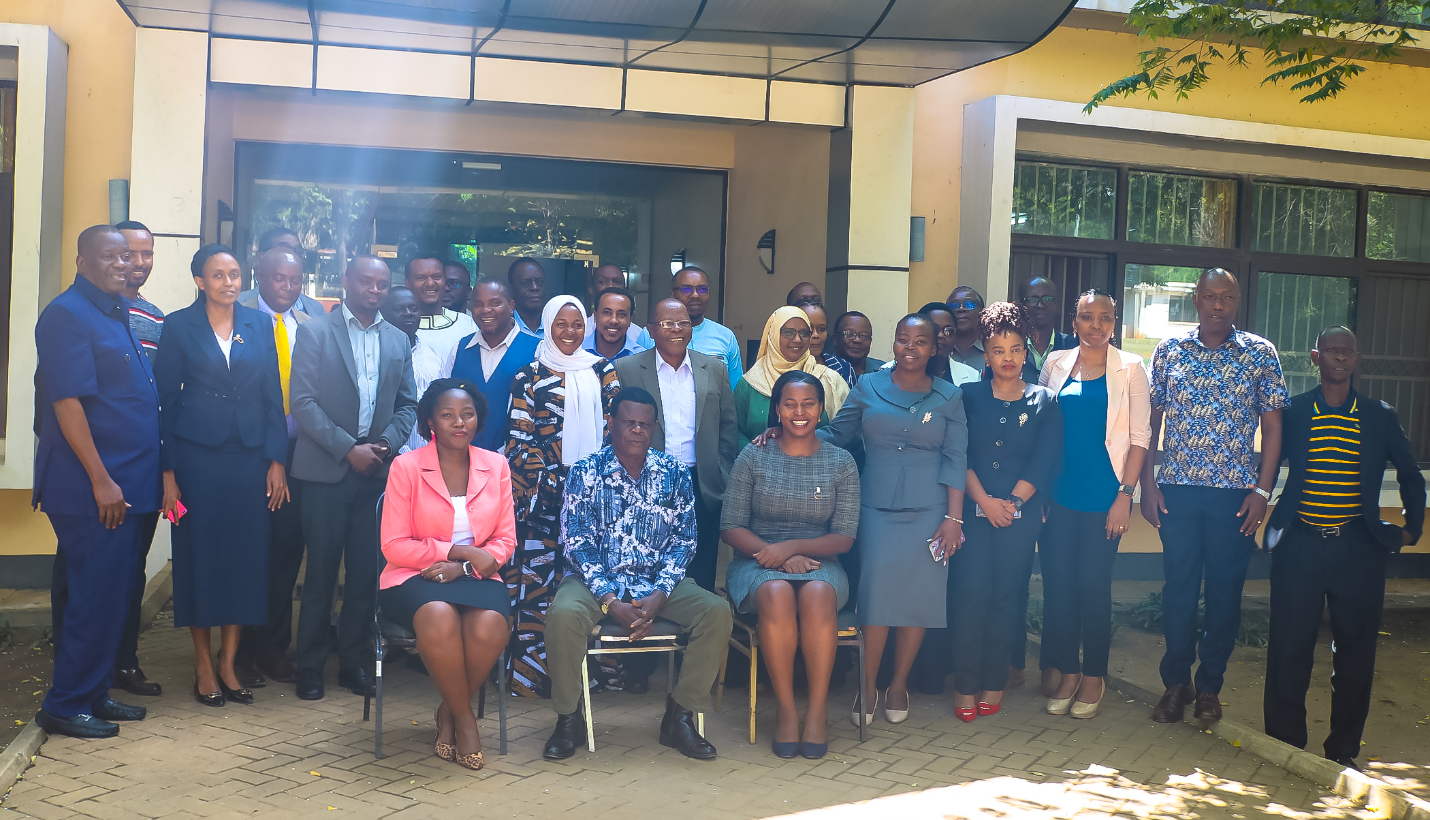REFOREST students and their lecturers during an excursion in Mazumbai montane forest
Western Usambara-Tanzania (Photo credit: Mazumbai staff)
Forestry is the science or art of managing forests. There are two types of forests i.e. naturally grown (natural forests) and planted by man (plantation forests). According to global forest resource assessment of 2020 by the Food and Agriculture Organisation of the United Nations (FAO), forests and woodlands cover 55% of the total land cover (88,580,000 hectares) of the Republic of Tanzania. The governance of these forests and woodlands in Tanzania is premised on the forest policy of 1998 with clear linkage between biodiversity conservation and economic development. However, the lack of balance by government to enforce compliance with rules and regulations to enable adjacent communities and enterprises utilize the forest resources sustainably has plunged the forests into over-exploitation of existing forest resources. Currently, the unique biodiversity of the tropical rainforests of Arc Mountains of Usambara and the surrounding woodlands are under threat from high deforestation and forest degradation due to increased human pressures such as agricultural expansion, livestock grazing, wild fires, and unsustainable utilization of forest resources. Sustainable forestry encompasses forests, the wildlife habits protection for both current and future generations to benefit from the healthy ecosystem goods and services arising from such forests. It is among the best options to balance biodiversity conservation and community livelihood agenda in fragmented forest landscapes with high human population.
Sokoine University of Agriculture, through the REFOREST Programme organised a field excursion for the Forest Science PhD students, which took place from 23rd – 26th November 2021 to Tanga and Arusha regions. The purpose of the excursion was to expose the Reforest PhD students to the different aspects of sustainable forest management and utilisation.
LEGACY OF REMNANT PRISTINE FOREST FOR BIODIVERSITY CONSERVATION AND SUPPLY OF ECOSYSTEM SERVICES: A CASE OF MAZUMBAI MONTANE FOREST
Mazumbai forest is a pristine montane tropical rainforest located in western Usambara Arc mountain ranges. The history of Mazumbai forest dates back to 1940s when the family of Mr. Tanner owned the forest for conservation of biodiversity and production of wood to cure tea. In 1968, Mr. John Tanner (a Swiss national) donated the conservation portion of the forest to by then Dar es Salaam University College for training and research. At the same time, he donated remaining production portion together with the tea estate to the local communities. In 1982, Mr. John Tanner and the family left Tanzania after he had constructed a small hydropower for generating electricity. Currently, the conservation portion of Mazumbai forest is now the property of Sokoine University of Agriculture and it provides unique attributes for research. It has a total area of 322.5 hectares (320 ha of montane evergreen tropical forest and 2.5 ha of residential area). The forest is located at an altitude range of 1,300 – 1,900 meter above sea level and it is comprised of 67 tree species including beautiful African Violets flower (Saintpaulia) and many endemic animal species. Notably among the endemic animal species are; snake – Usambara bush viper; Chameleons (Usambara two-horned and Usambara pitted pygmy chameleons), elephant shrew, rock and tree hyrax among others. The forest is pristine and it hosts most of the oldest trees in Arc Usambara mountain ranges. The oldest tree in the forest has a diameter of approximately 260 cm measured at 1.3 m above the ground. The forest offers beautiful sceneries such as trees with large creeping roots of up to 12 m and buttresses of up to 160 cm high; rock and tree caves, saprophytic plant interactions and waterfalls for ecotourism. Importantly, the forest is the major source of fresh water to the local communities and it forms part of the 25% of water supplied by Usambara Arc mountain forests in Tanzania. It is also a source of seed bank for many indigenous tree species including Allanblackia stuhlmannii valued for its desirable oil characteristics. The oil has significant global market potential especially in Europe because the European Union approved its usage in foodstuffs. The forest also harbors wild coffee that the researchers have overtime been using to breed coffee varieties against drought, pest and disease resistance. The Mazumbai forest is a well conserved forest and many students and researchers both locally and internationally have used it for research activities.
Students and lecturers viewing Usambara bush viper (above) and observing creeping roots of Entandrophragma (below) at Mazumbai forest (Photo credit: Alberto and Osvaldo)
Students and lecturers discussing about biodiversity conservation (above) and wild coffee (below) Who should bear the costs so as to have continued supply of ecosystem goods and services (Photo credit: Alberto and Osvaldo)
Commercialization of clonal Eucalyptus for bioenergy production and income generation
In Tanzania, arid, semi-arid and dry sub-humid areas cover 61 % of total land area (88,580,000 ha). The unfavourable weather conditions in those areas affect commercial exotic tree species growing. In a bid to increase plantation forestry in Tanzania, clonal eucalyptus (GT – Grandis tereticornis, GC – Grandis camaldulensis and GU – Grandis urophylla) hybrids were introduced from South Africa by the Tanzania Forestry Research Institute in collaboration with the Gatsby Trust (UK). The clones were matched to the different sites i.e. highlands, coastal zones and arid and semi-arid areas. Classification of best performing clones for the different agro-ecological zones were conducted to help boost commercial tree growing for wood (bioenergy, poles and timber) production. Tree farmers have adopted growing of these clones to enhance forest productivity, profitability and livelihoods. Eucalyptus clones are preferred at times to the landraces because they are of good quality due to their desirable properties such as fast and uniform growth, drought resistance, resistance to pests and diseases, and high productivity per unit area. At TaFORI, REFOREST Programme PhD students were exposed to the different processes of producing clones from selecting the shoots for preparing the cuttings for propagating into seedlings as indicated in the pictorials below;
Eucalyptus clones mother garden and cuttings harvesting process (Photo credit: Daniel and Joshua).
Eucalyptus clones propagation and hardening sites (Photo credit: Alberto)
Commercial forestry research and livelihoods: Sokoine University of Agriculture Training Forest (SUATF) Olmotonyi
Research and training is a key component of forest management and utilisation because it generates information on best practices to increase forest productivity, reduce incidences of pests and diseases and or increase market value for the forest products. SUATF is linking ecosystem knowledge and forest plantation production to promote sustainable forestry. SUATF is located at the slopes of Mount Meru in Olmotonyi-Arusha region and it covers an area of 865 hectares (25 hectares of residential and 840 hectares of forest plantation). The forest is composed of Pinus patula (65%), Cupressus lustanica (21%), Grevillea robusta (6.7%), Eucalyptus saligna (3.8%), Acacia melanoxylon (1.7%), Cedrella odorata (0.6%), and Olea capensis (0.2%). It offers training to students in tree nursery management, silviculture, forest protection and forest harvesting. Currently, management has reduced the capacity of the nursery to produce only 32,400 seedlings annually since the forest plantation has reached the status of a normal forest where there are all age classes i.e. from 1 year old to mature tree crops awaiting harvesting to generate revenue to the government. Harvesting of logs and sawmilling of timber is done using two old sawmills based on the forest management plan. The allowable cut is 13,200 m3 but the two installed sawmills can only process about 10,000 m3 annually. Aware of the low recovery rates (<50%) of the installed sawmills, SUA management through the College of Forestry, Wildlife and Tourism is now in the process of procuring a modern sawmill with better recovery to aid timber processing since there is huge demand for lumber both locally in Tanzania and East Africa region.
The most outstanding research from SUATF is on the management of Cypress Aphid (Cinara cupressi) that had affected the growth of Cypress trees (Cupressus lusitanica) in East Africa. It is now clear that, correct site matching, intercropping and carrying out timely tending operations reduce the incidence of the pest attack on cypress trees. However, there are still challenges of wild animals debarking trees leading to tree mortality and or low quality of wood. Hence, there need for further research to be conducted to determine the most appropriate mechanisms to deter animals as the current scaring methods are not very effective.
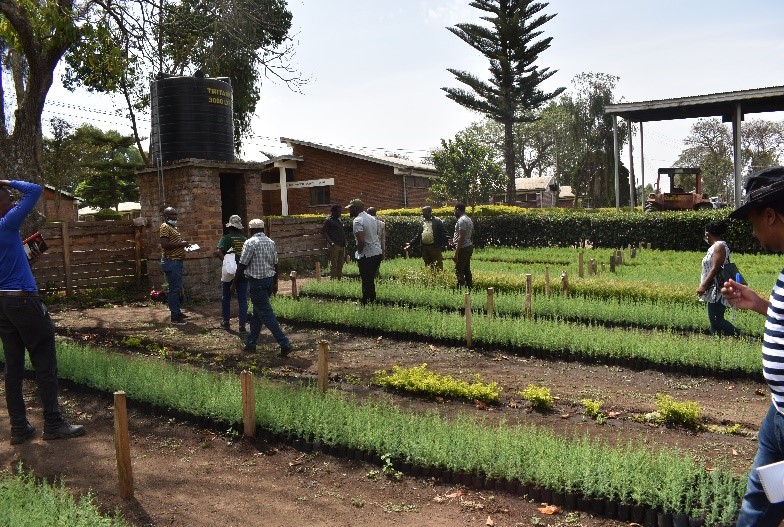
REFOREST students having a briefing at SUATF (left) and Cypress seedlings (right) at the nursery ready for planting (Photo credit: Alberto)
Prof. Ishengoma highlighting issues related to sawmilling, timber grading and marketing to students at SUATF (Photo credit: Alberto)
Adoption of Taungya System as a cost-effective option for tree establishment and food production
Tree establishment is very costly especially in terms of labour to carrying out the weeding regimes. SUATF has successfully managed to employ use of “Taungya system” whereby harvested compartments are demarcated into plots of 20 x 20 m and allocated on permit basis to adjacent communities to grow food crops on one year before planting the trees. In the second year, trees are planted among food crops and managed by the farmers until at the time of tree canopy closure. It was evident that farmers are adhering to the terms and conditions stipulated in the permits since SUATF staff constantly monitor them. The taungya system allows farmers/households who are landless to address food insecurity and generate income because of high crop yields. However, there is still no clear information on the long-term effect of taungya tree-crop integration on tree growth performance.
SUATF manager explains how the taungya plots are managed on ground (left) and Cypress trees (right) growing with maize in a taungya plot (Photo credit: Alberto)
Trial plots for Corymbia, Eucalyptus and clonal Pines
Poor tree germplasm base and over reliance on few tree species affects forest productivity. Forest Development Trust (FDT) has since 2014 embarked on importation of tree species germplasm and collaborating with research institutions to conduct research on species site matching. In 2019, FDT collaborated with SUATF and TaFORI to have species trial experiments established at Olmotonyi forest reserve. The species include; Corymbia (C. torrelliana and C. Citriodora); various eucalyptus species and pines clonal hybrid and pure species. The technologies tested are site species matching and silvicultural operations.
Corymbia spp, eucalyptus spp and pines clonal/pure species trial experiments at Olmotonyi forest (Photo credit: Daniel)
Prepared by REFOREST Programme Students
